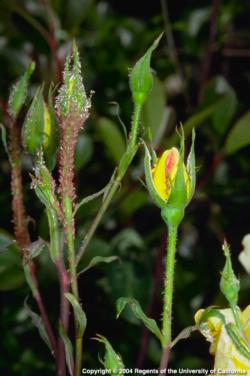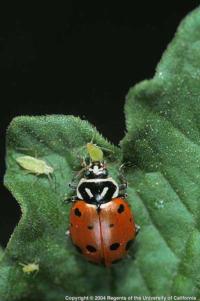Aphids and how to control them
-
Warm spring days bring unwelcome visitors to the garden: aphids. These small, pear-shaped, soft-bodied insects suck the juices out of a wide variety of landscape and edible plants. Because each adult aphid can produce up to 80 offspring a week, adult populations can increase rapidly.
 Tender new plant growth attracts aphids.
Tender new plant growth attracts aphids.
Moderate numbers of leaf-feeding aphids usually do not cause significant damage in gardens. Large populations, however, can cause leaves to curl, yellow or distort. New shoots can be stunted. As aphids feed, they excrete a sticky substance, called honeydew, which often turns black with the growth of a sooty mold fungus.
An ounce of prevention
Aphids love tender new plant growth fostered by nitrogen fertilizer. Don’t give your plants more fertilizer than they need and apply it in small amounts throughout the season, rather than all at once. If you build healthy soil with compost and other organic materials, you can reduce fertilizer applications.
Monitoring
Check your plants regularly for aphids—at least twice weekly when plants are flush with new growth. Many species of aphids cause the greatest damage when temperatures are between 65 and 80 degrees. Be sure to inspect the undersides of leaves carefully because aphids are often green, blending in with the leaf color. Once aphid numbers soar and cause leaves to curl, it is harder to control them because they are hidden within the leaves, sheltered from natural enemies and sprays.
Ants can be a tip-off
If you see a number of ants climbing up a tree trunk or shrub, check for aphids on the branches and leaves above. Ants like to feed on the honeydew that aphids produce and will protect aphids from predators and parasites. Managing ants is one way to control aphids.
If you see ants crawling up a tree or woody plant, wrap the trunk with a band of fabric tree wrap or duct tape and then apply a sticky material like Tanglefoot to the wrap. Alternatively, place ant stakes or baits on the ground to control the ants.Control measures Aphids are a favorite meal for lady beetles.
Aphids are a favorite meal for lady beetles.
Here are some suggestions for controlling aphids, starting with the least toxic. Be sure to treat the underside of leaves. Repeat treatments at frequent intervals may be necessary.- If only a few leaves are affected, you can run a gloved finger along the surfaces, squishing as you go.
- Blast the plants with water from a hose or sprayer.
- Spray with an insecticidal soap.
- Spray with a botanical insecticide containing neem oil. Follow label instructions.
You can leave the job to Mother Nature. Aphids are a favorite meal for many beneficial insects, such as lady beetles, soldier beetles and lacewings. Create a good habitat for these beneficials in your garden, and they will help you manage the aphid population.
Contributors: Faith Brown, Nanette Londeree


